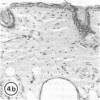Abstract
The pathological scaling in recessive x-linked ichthyosis is associated with accumulation of abnormal quantities of cholesterol sulfate in stratum corneum (J. Clin. Invest. 68:1404-1410, 1981). To determine whether or not cholesterol sulfate accumulates in recessive x-linked ichthyosis as a direct result of the missing enzyme, steroid sulfatase, we quantitated both steroid sulfatase and its substrate, we quantitated both steroid sulfatase and its substrate, cholesterol sulfate, in different epidermal strata, as well as within stratum corneum subcellular fractions obtained from normal human and neonatal mouse epidermis and from patients with recessive x-linked ichthyosis. In normal human and mouse epidermis, steroid sulfatase activity peaked in the stratum granulosum and stratum corneum, and negligible activity was detectable in lower epidermal layers. In contrast, in recessive x-linked ichthyosis epidermis, enzyme levels were virtually undetectable at all levels. In normal human stratum corneum, up to 10 times more steroid sulfatase activity was present in purified peripheral membrane preparations than in the whole tissue. Whereas in normal human epidermis cholesterol sulfate levels were lowest in the basal/spinous layer, and highest in the stratum granulosum, in recessive x-linked ichthyosis the levels were only slightly higher in the lower epidermis, but continued to climb in the stratum corneum. In both normal and in recessive x-linked ichthyosis stratum corneum, cholesterol sulfate appeared primarily within membrane domains, paralleling the pattern of steroid sulfatase localization. Finally, the role of excess cholesterol sulfate in the pathogenesis of recessive x-linked ichthyosis was directly tested by topical applications of this substance, which produced visible scaling in hairless mice in parallel to an increased cholesterol sulfate content of the stratum corneum. These results demonstrate an intimate relationship between steroid sulfatase and cholesterol sulfate in normal epidermis: both are concentrated in the outer epidermis (stratum corneum and stratum granulosum), and both are localized to membrane domains. Presumably, as a result of this distribution pattern, continued enzymatic degradation of substrate occurs in normal epidermis, thereby preventing excessive accumulation of cholesterol sulfate. In contrast, in recessive x-linked ichthyosis, degradation of cholesterol sulfate does not occur and cholesterol sulfate accumulates specifically in the stratum corneum, where it produces visible scale.
Full text
PDF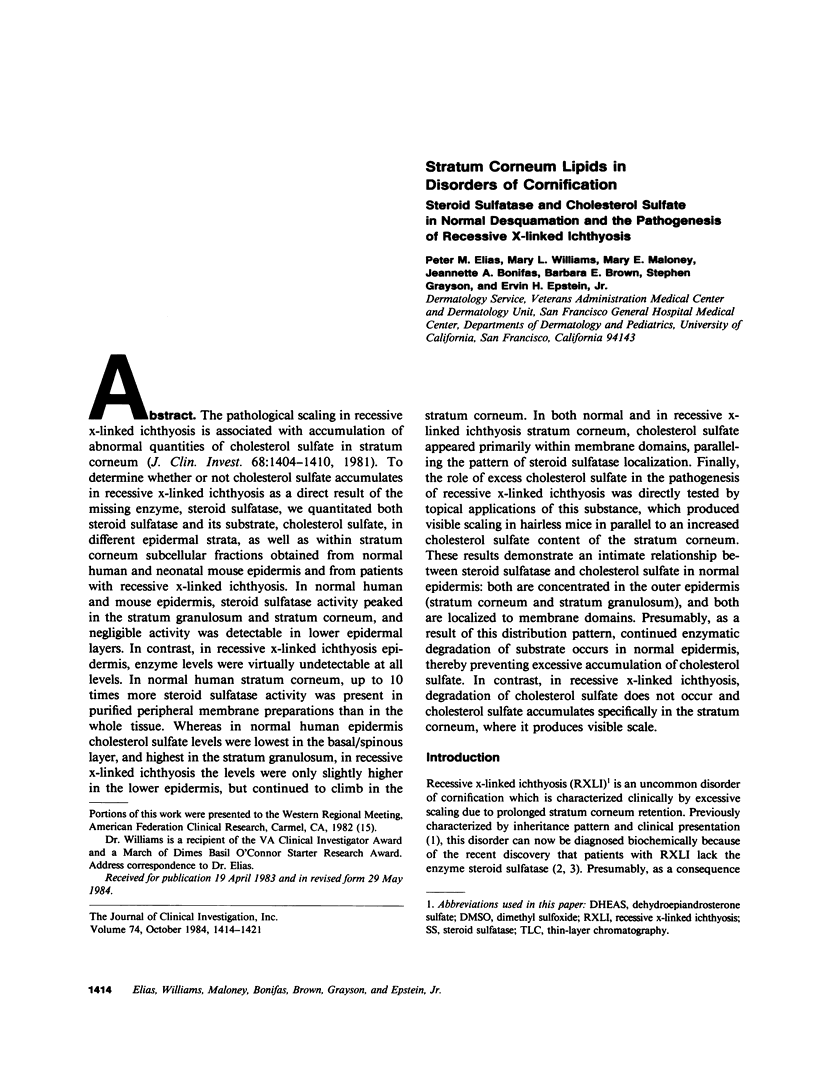
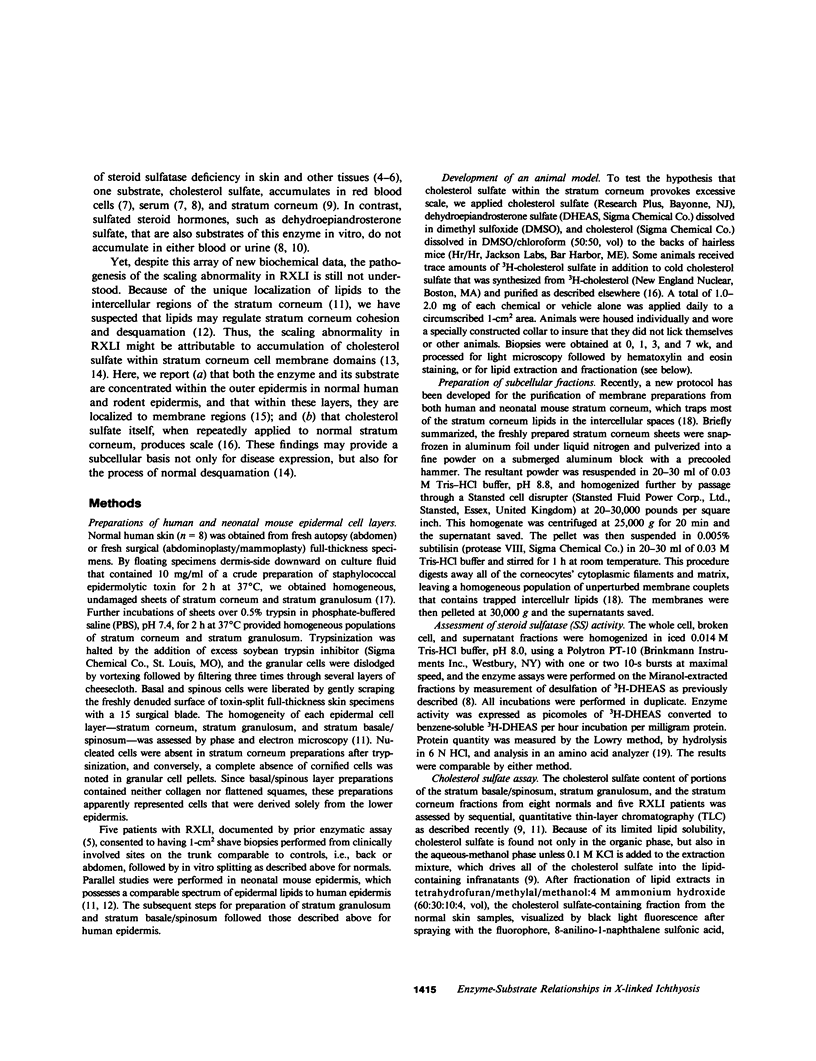

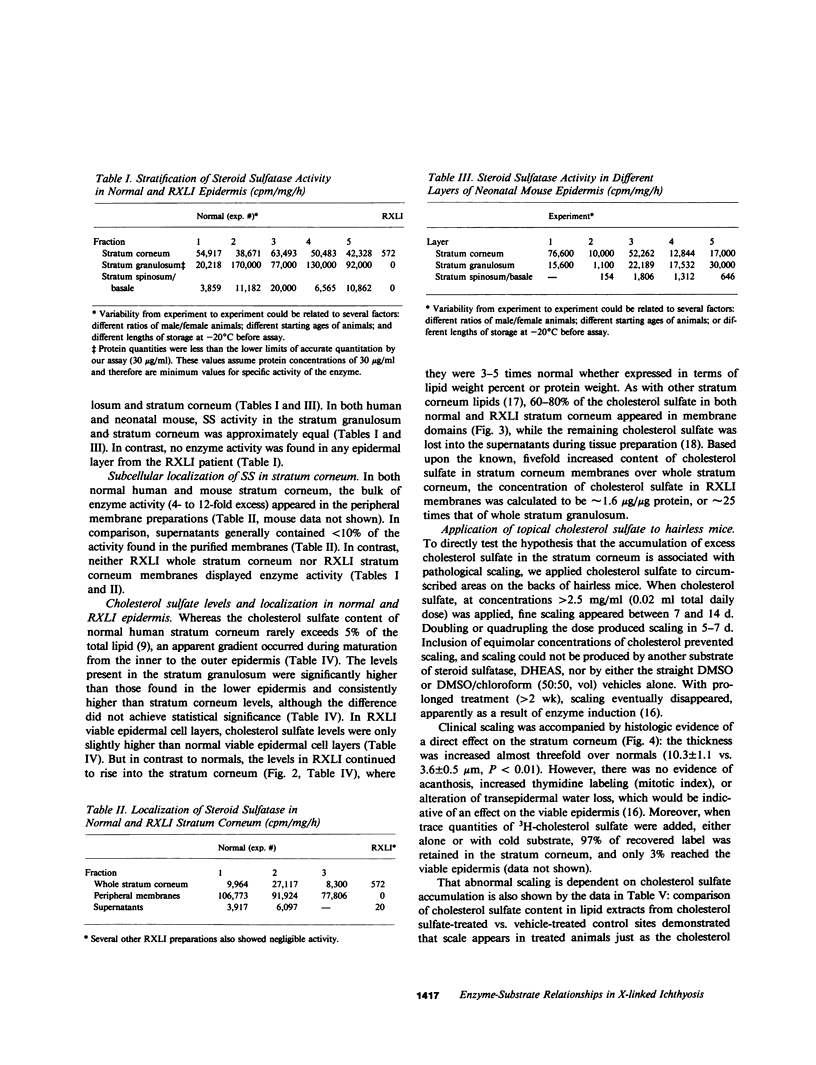
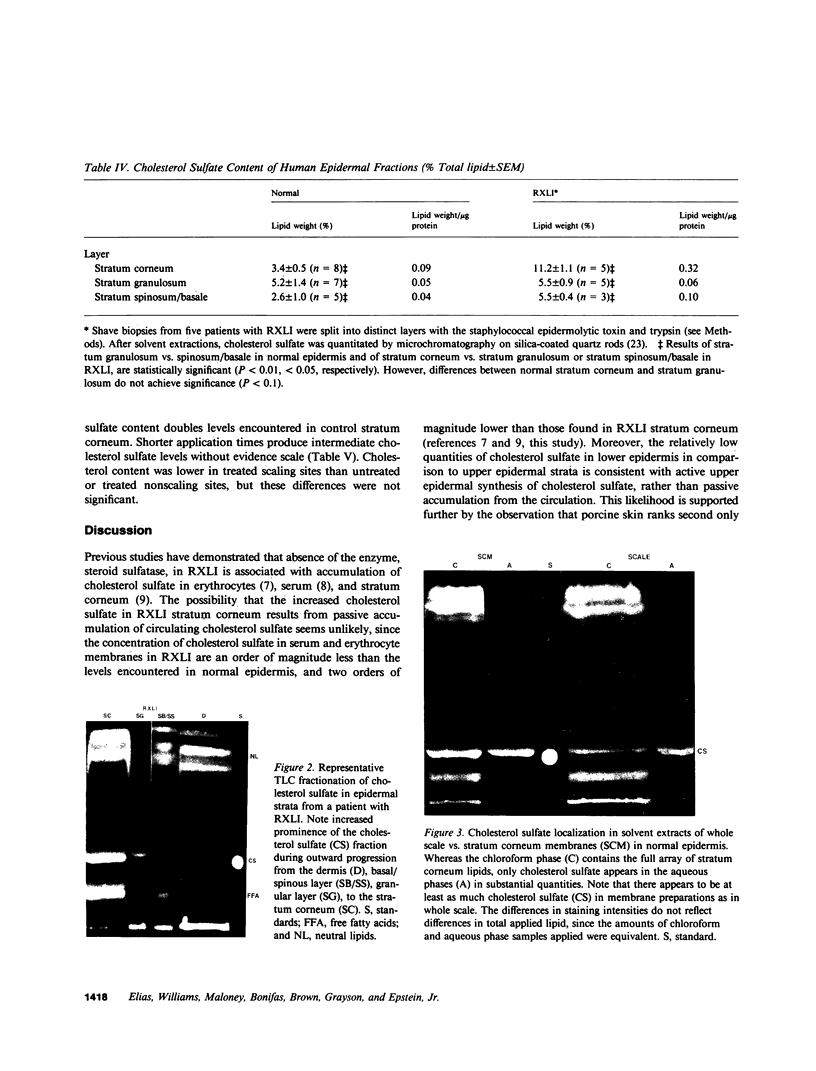
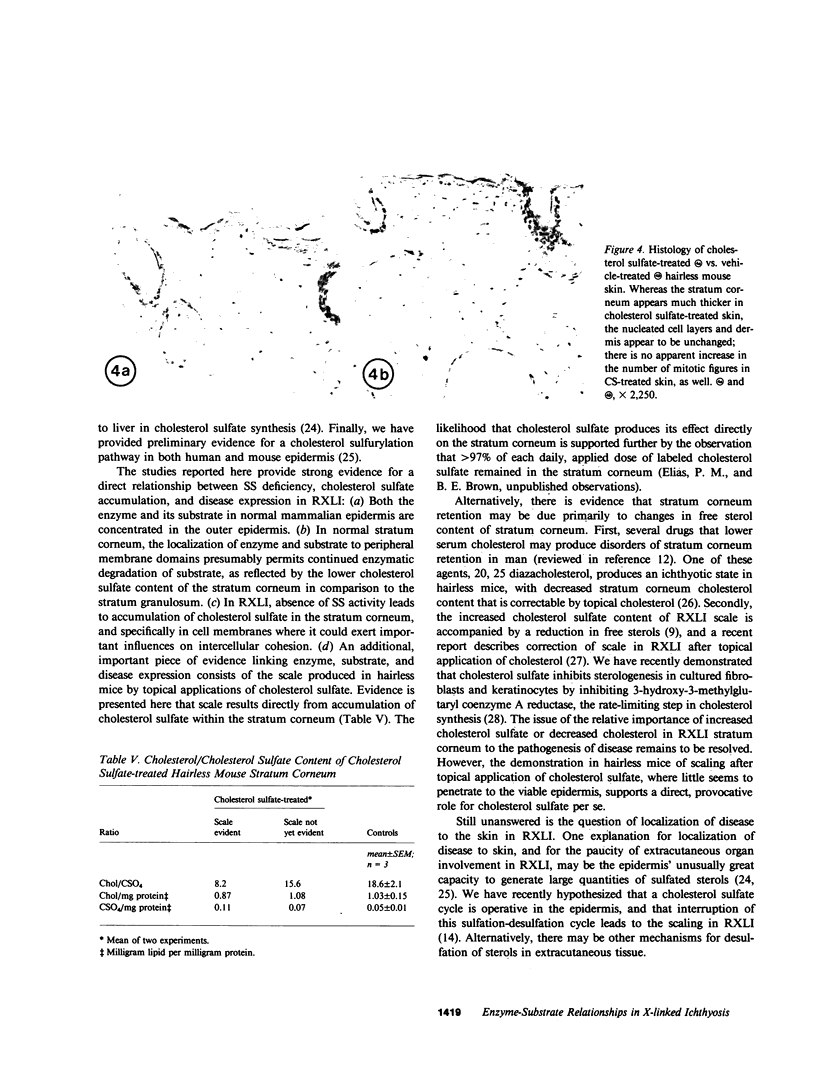

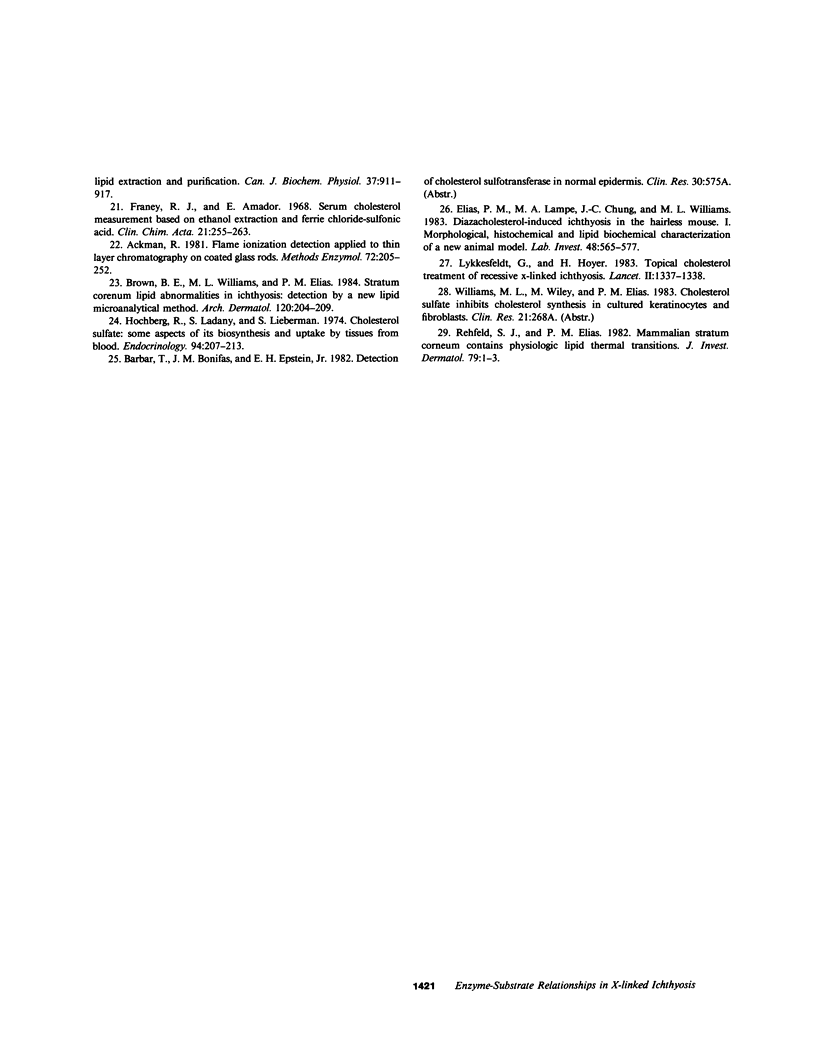
Images in this article
Selected References
These references are in PubMed. This may not be the complete list of references from this article.
- Ackman R. G. Flame ionization detection applied to thin-layer chromatography on coated quartz rods. Methods Enzymol. 1981;72:205–252. doi: 10.1016/s0076-6879(81)72013-5. [DOI] [PubMed] [Google Scholar]
- BLIGH E. G., DYER W. J. A rapid method of total lipid extraction and purification. Can J Biochem Physiol. 1959 Aug;37(8):911–917. doi: 10.1139/o59-099. [DOI] [PubMed] [Google Scholar]
- Bergner E. A., Shapiro L. J. Increased cholesterol sulfate in plasma and red blood cell membranes of steroid sulfatase deficient patients. J Clin Endocrinol Metab. 1981 Jul;53(1):221–223. doi: 10.1210/jcem-53-1-220. [DOI] [PubMed] [Google Scholar]
- Brown B. E., Williams M. L., Elias P. M. Stratum corneum lipid abnormalities in ichthyosis. Detection by a new lipid microanalytical method. Arch Dermatol. 1984 Feb;120(2):204–209. [PubMed] [Google Scholar]
- Elias P. M., Brown B. E., Fritsch P., Goerke J., Gray G. M., White R. J. Localization and composition of lipids in neonatal mouse stratum granulosum and stratum corneum. J Invest Dermatol. 1979 Nov;73(5):339–348. doi: 10.1111/1523-1747.ep12550377. [DOI] [PubMed] [Google Scholar]
- Elias P. M. Epidermal lipids, membranes, and keratinization. Int J Dermatol. 1981 Jan-Feb;20(1):1–19. doi: 10.1111/j.1365-4362.1981.tb05278.x. [DOI] [PubMed] [Google Scholar]
- Elias P. M., Fritsch P., Tappeiner G., Mittermayer H., Wolff K. Experimental staphylococcal toxic epidermal necrolysis (TEN) in adult humans and mice. J Lab Clin Med. 1974 Sep;84(3):414–424. [PubMed] [Google Scholar]
- Elias P. M., Lampe M. A., Chung J. C., Williams M. L. Diazacholesterol-induced ichthyosis in the hairless mouse. I. Morphologic, histochemical, and lipid biochemical characterization of a new animal model. Lab Invest. 1983 May;48(5):565–577. [PubMed] [Google Scholar]
- Epstein E. H., Jr, Leventhal M. E. Steroid sulfatase of human leukocytes and epidermis and the diagnosis of recessive X-linked ichthyosis. J Clin Invest. 1981 May;67(5):1257–1262. doi: 10.1172/JCI110153. [DOI] [PMC free article] [PubMed] [Google Scholar]
- Epstein E. H., Jr, Munderloh N. H. Isolation and characterization of CNBr peptides of human (alpha 1 (III) )3 collagen and tissue distribution of (alpha 1 (I) )2 alpha 2 and (alpha 1 (III) )3 collagens. J Biol Chem. 1975 Dec 25;250(24):9304–9312. [PubMed] [Google Scholar]
- Epstein E. H., Williams M. L., Elias P. M. The epidermal cholesterol sulfate cycle. J Am Acad Dermatol. 1984 May;10(5 Pt 1):866–868. doi: 10.1016/s0190-9622(84)80144-9. [DOI] [PubMed] [Google Scholar]
- Franey R. J., Amador E. Serum cholesterol measurement based on ethanol extraction and ferric chloride-sulfuric acid. Clin Chim Acta. 1968 Aug;21(2):255–263. doi: 10.1016/0009-8981(68)90135-6. [DOI] [PubMed] [Google Scholar]
- Goldsmith L. A. The ichthyoses. Prog Med Genet. 1976;1:185–210. [PubMed] [Google Scholar]
- Grayson S., Elias P. M. Isolation and lipid biochemical characterization of stratum corneum membrane complexes: implications for the cutaneous permeability barrier. J Invest Dermatol. 1982 Feb;78(2):128–135. doi: 10.1111/1523-1747.ep12505953. [DOI] [PubMed] [Google Scholar]
- Hochberg R. B., Ladany S., Lieberman S. Cholesterol sulfate: some aspects of its biosynthesis and uptake by tissues from blood. Endocrinology. 1974 Jan;94(1):207–213. doi: 10.1210/endo-94-1-207. [DOI] [PubMed] [Google Scholar]
- Koppe G., Marinković-Ilsen A., Rijken Y., De Groot W. P., Jöbsis A. C. X-linked icthyosis. A sulphatase deficiency. Arch Dis Child. 1978 Oct;53(10):803–806. doi: 10.1136/adc.53.10.803. [DOI] [PMC free article] [PubMed] [Google Scholar]
- Kubilus J., Tarascio A. J., Baden H. P. Steroid-sulfatase deficiency in sex-linked ichthyosis. Am J Hum Genet. 1979 Jan;31(1):50–53. [PMC free article] [PubMed] [Google Scholar]
- Lykkesfeldt G., Høyer H. Topical cholesterol treatment of recessive X-linked ichthyosis. Lancet. 1983 Dec 10;2(8363):1337–1338. doi: 10.1016/s0140-6736(83)91093-0. [DOI] [PubMed] [Google Scholar]
- Rehfeld S. J., Elias P. M. Mammalian stratum corneum contains physiologic lipid thermal transitions. J Invest Dermatol. 1982 Jul;79(1):1–3. doi: 10.1111/1523-1747.ep12510367. [DOI] [PubMed] [Google Scholar]
- Ruokonen A., Oikarinen A., Palatsi R., Huhtaniemi I. Serum steroid sulphates in ichthyosis. Br J Dermatol. 1980 Sep;103(3):245–248. doi: 10.1111/j.1365-2133.1980.tb07240.x. [DOI] [PubMed] [Google Scholar]
- Ruokonen A., Oikarinen A. Steroid sulphatase activity in the skin biopsies of various types of ichthyosis. Br J Dermatol. 1981 Sep;105(3):291–295. doi: 10.1111/j.1365-2133.1981.tb01288.x. [DOI] [PubMed] [Google Scholar]
- Webster D., France J. T., Shapiro L. J., Weiss R. X-linked ichthyosis due to steroid-sulphatase deficiency. Lancet. 1978 Jan 14;1(8055):70–72. doi: 10.1016/s0140-6736(78)90005-3. [DOI] [PubMed] [Google Scholar]
- Williams M. L., Elias P. M. Stratum corneum lipids in disorders of cornification: increased cholesterol sulfate content of stratum corneum in recessive x-linked ichthyosis. J Clin Invest. 1981 Dec;68(6):1404–1410. doi: 10.1172/JCI110391. [DOI] [PMC free article] [PubMed] [Google Scholar]






